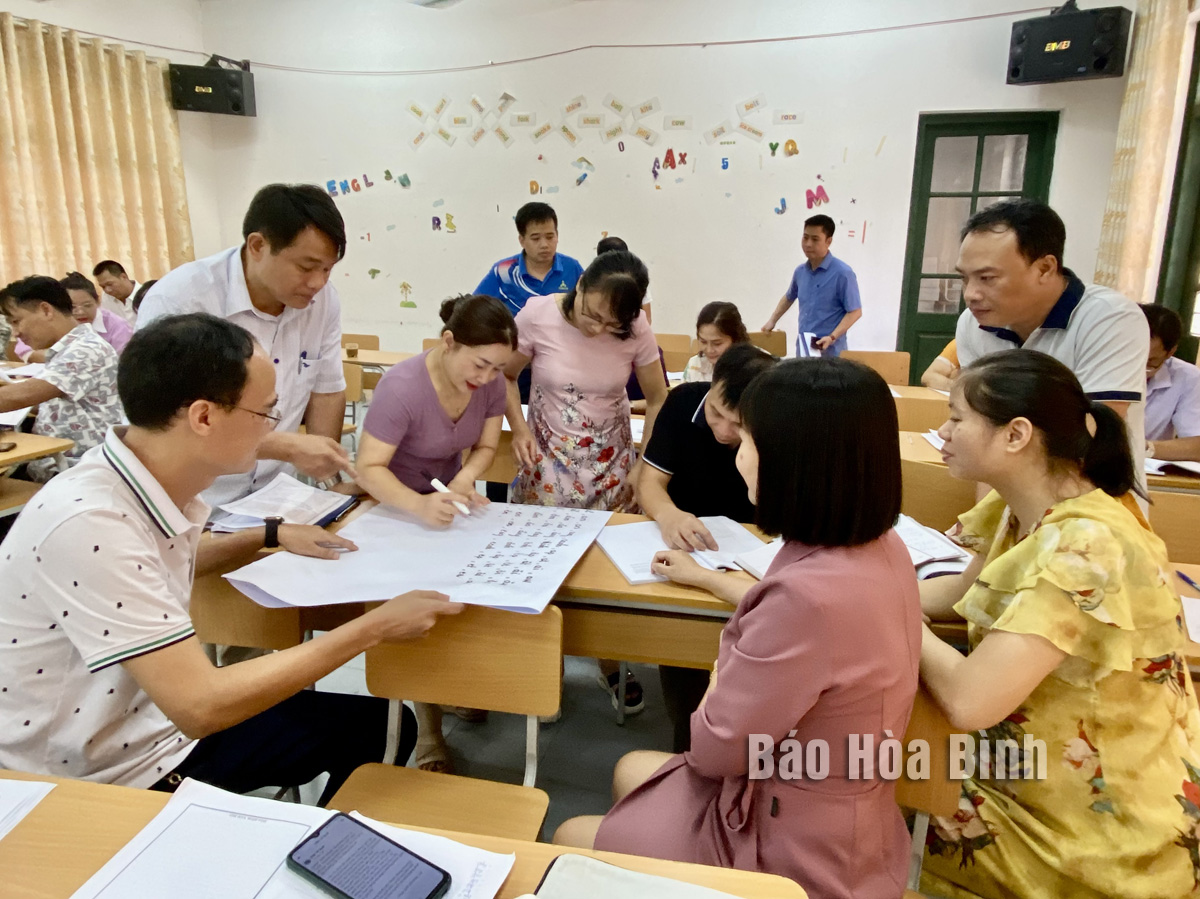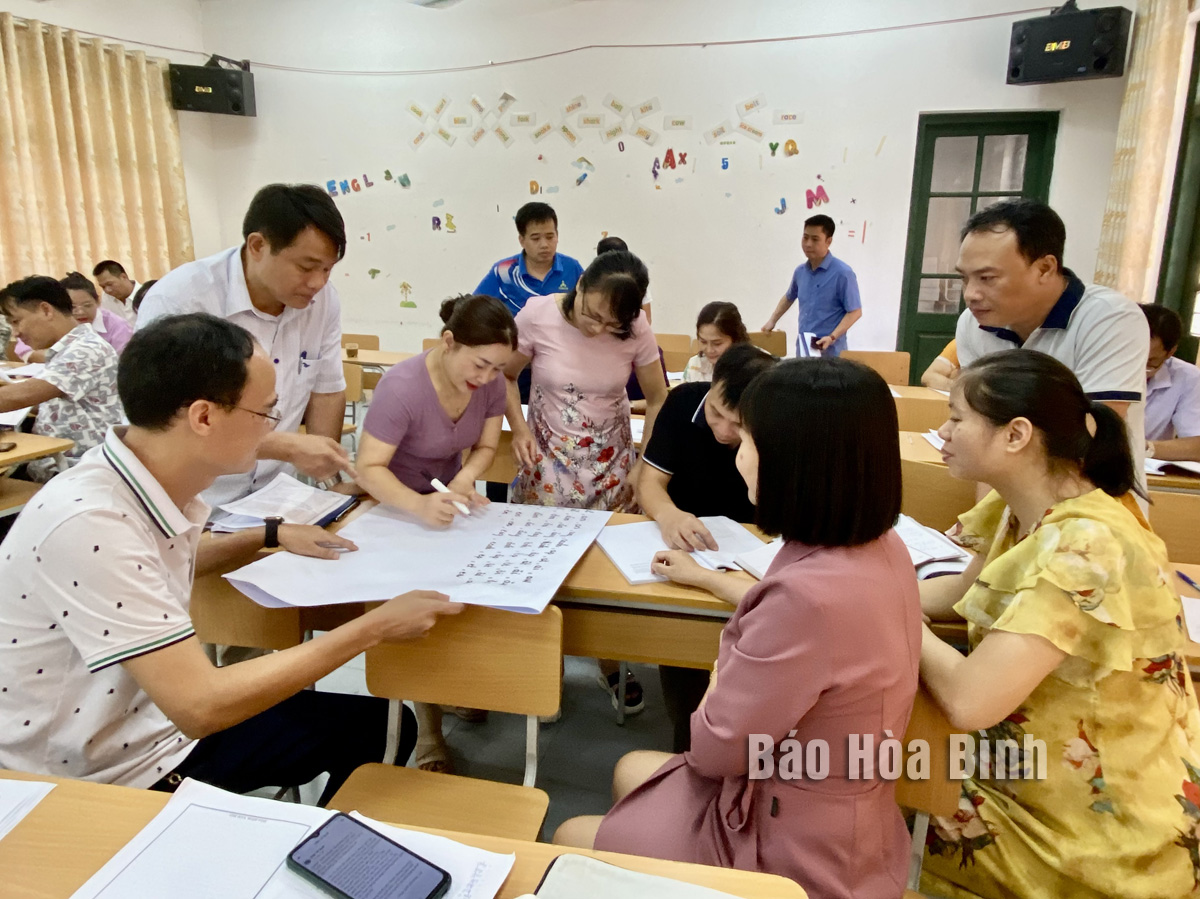
As the Muong ethnic people make up more than 63% of Hoa Binh province’s population, joint efforts have been made to preserve the Muong language. The Muong community in the province now use both Vietnamese and their mother tongue daily with the latter preferred in communication in family life.
Students at a Muong language class.
In 2016, Hoa Binh province developed and officially put into use the Muong ethnic script which helps Muong ethnic children learn and use the Muong language – a way to preserve and promote national cultural identity.
According to folk culture researcher Bui Huy Vong, from Huong Nhuong commune, Lac Son district, the Muong ethnic script plays an important role in preserving the intangible cultural heritage of Mo Muong accurately, completely and scientifically.
Mo Muong is a job and also a performance practised at funerals, religious festivals, and life cycle rituals by the Muong ethnic group. The art consists of Mo prayers and performances, by Mo practitioners, or Mo artisans. Through generations, Mo prayers have been passed down verbally in the community.
Vong said that the script of Mo Muong can be used and translated into other languages to facilitate the establishment of scientific documents about Mo Muong. Moreover, with the scrips, the Muong language can live forever with other Muong cultural values. Seeing the fact that a group of the young generation of Muong people or local State employees doing mass mobilisation work cannot speak the Muong language, the provincial People’s Committee in 2019 approved a project on Muong language teaching and learning in the 2018-2025 period with a vision to 2035.
In 2023, Hoa Binh Pedagogical College opened Muong language classes for local officials, civil servants and public employees.
Do An, a student of a Muong language class, said that he now can speak Muong language which is useful for his work. Moreover, it helps him understand more about the customs and culture of the Muong ethnic group.
According to the 2024 - 2025 plan, the province’s Department of Education and Training will open other classes for 2,500 local officials, civil servants and public employees plus 2,500 teachers of schools across the province.
In addition, the province also pays attention to popularising and mobilising the community to preserve the Muong language, particularly through folk songs.
With an increasingly vibrant and widespread emulation movement aimed at building cultured residential areas and cultured families, Yen Thuy District has been making steady progress toward improving both the material and spiritual well-being of its people, while fostering a civilized, prosperous, beautiful, and progressive community.
Once lacking recreational spaces and community facilities, Residential Group 2 in Quynh Lam Ward (Hoa Binh City) has recently received attention for the construction of a new, spacious, and fully equipped cultural house. The project followed the model of state support combined with public contributions in both labor and funding.
The "All people unite to build cultural life" movement, which has been effectively integrated with Kim Boi district’s socio-economic development goals, is fostering a lively spirit of emulation across local residential areas, hamlets, villages, public agencies, and enterprises. In addition, through the initiative, traditional cultural values are being preserved and promoted, while community solidarity and mutual support in poverty reduction and economic development are being strengthened.
A working delegation of the Hoa Binh provincial People’s Committee led by its Permanent Vice Chairman Nguyen Van Toan on June 11 inspected the progress of a project to build the Mo Muong Cultural Heritage Conservation Space linked to tourism services in Hop Phong commune, Cao Phong district.
Born and growing in the heroic land of Muong Dong, Dinh Thi Kieu Dung, a resident in Bo town of Kim Boi district, in her childhood was nurtured by the sweet lullabies of her grandmother and mother. These melodies deeply imprinted on her soul, becoming an inseparable part of her love for her ethnic group's culture. For over 20 years, this love for her hometown has driven Dung to research, collect, and pass down the cultural values of the Muong people to future generations.
In the final days of May, the Ethnic Art Troupe of Hoa Binh Province organized performances to serve the people in remote, mountainous, and particularly disadvantaged areas within the province. These were not just ordinary artistic shows, but they were the meaningful journeys aimed at spreading cultural values, enhancing the spiritual life of the people and contributing to the preservation of ethnic minority cultural identities.



